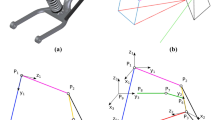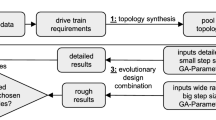Abstract
Demands on larger motors and battery packs in electric vehicles cause a suspension layout issue not appearing in gas-powered vehicles. Motivated by this need, our research aims to design a new-concept suspension applicable to electric vehicles, where given space-related constraints are satisfied without scarifying their kinematic performance. Here, we propose a three-phase design process for the synthesis of rear suspensions of an electric vehicle: concept topology design, kinematic feature identification, and detailed design. For the concept design to determine the mechanism topology, we employ the topology optimization method developed for mechanism synthesis subjected to a reduced suspension design space as well as a tighter condition on the camber rate—known as yielding better vehicle’s dynamic performance. The next phase is to extract the underlying kinematic features of the synthesized suspension obtained by the topology optimization method as it may be difficult to directly figure out how the synthesized mechanism functions kinematically. For the extraction, we propose a connectivity-mapping technique followed by the wrench calculation. This phase is followed by the final detailed design to meet the specific requirements imposed on the target suspensions. The new suspensions designed by the proposed three-phase design approach will be shown to successfully resolve the suspension layout issue typically encountered in electric vehicles.

















Similar content being viewed by others
References
Frecker MI, Ananthasuresh GK, Nishiwaki S, Kikuchi N, Kota S (1997) Topological synthesis of compliant mechanisms using multi-criteria optimization. J Mech Des 119:238–245. https://doi.org/10.1115/1.2826242
Han SM, Kim SI, Kim YY (2017) Topology optimization of planar linkage mechanisms for path generation without prescribed timing. Struct Multidiscip Optim 56:501–517
Haug EJ (1989) Computer aided kinematics and dynamics of mechanical systems, vol 1. Allyn and Bacon Boston, Boston
Heo J, Lee U, Lee S (2009) Development of a method to compute the kingpin axis using screw axis theory based on suspension-parameter-measuring device data. Proc Inst Mech Eng D: J Automob Eng 223:519–531
Kang SW, Kim YY (2018) Unified topology and joint types optimization of general planar linkage mechanisms. Struct Multidiscip Optim 57:1955–1983
Kang JS, Yun JR, Lee JM, Tak TO (1997) Elastokinematic analysis and optimization of suspension compliance characteristics. SAE Technical Paper
Kang SW, Kim SI, Kim YY (2016) Topology optimization of planar linkage systems involving general joint types. Mech Mach Theory 104:130–160. https://doi.org/10.1016/j.mechmachtheory.2016.05.015
Kawamoto A (2005) Path-generation of articulated mechanisms by shape and topology variations in non-linear truss representation. Int J Numer Methods Eng 64:1557–1574. https://doi.org/10.1002/nme.1407
Kawamoto A, Bendsøe MP, Sigmund O (2004) Articulated mechanism design with a degree of freedom constraint. Int J Numer Methods Eng 61:1520–1545. https://doi.org/10.1002/nme.1119
Kim SI, Kim YY (2014) Topology optimization of planar linkage mechanisms. Int J Numer Methods Eng 98:265–286. https://doi.org/10.1002/nme.4635
Kim YY, Jang G-W, Park JH, Hyun JS, Nam SJ (2007) Automatic synthesis of a planar linkage mechanism with revolute joints by using spring-connected rigid block models. J Mech Des 129:930–940. https://doi.org/10.1115/1.2747636
Kim SI, Kang SW, Yi YS, Park J, Kim YY (2018) Topology optimization of vehicle rear suspension mechanisms. Int J Numer Methods Eng 113:1412–1433
Kwon S, Yi Y-S, Woo S, Kim YY, Kim SI (2019) Suspension system for vehicle, US10435068B2
Milliken WF, Milliken DL (1995) Race car vehicle dynamics, vol 400. Society of Automotive Engineers, Pittsburgh
Murray RM, Li Z, Sastry SS (1994) A mathematical introduction to robotic manipulation. CRC Press
Nam SJ, Jang G-W, Kim YY (2012) The spring-connected rigid block model based automatic synthesis of planar linkage mechanisms: numerical issues and remedies. J Mech Des 134:051002. https://doi.org/10.1115/1.4006266
Ohsaki M, Nishiwaki S (2009) Generation of link mechanism by shape-topology optimization of trusses considering geometrical nonlinearity. J Comput Sci Technol 3:46–53. https://doi.org/10.1299/jcst.3.46
Ohsaki M, Kanno Y, Tsuda S (2014) Linear programming approach to design of spatial link mechanism with partially rigid joints. Struct Multidiscip Optim 50:945–956. https://doi.org/10.1007/s00158-014-1094-y
Ohsaki M, Tsuda S, Miyazu Y (2016) Design of linkage mechanisms of partially rigid frames using limit analysis with quadratic yield functions. Int J Solids Struct 88:68–78. https://doi.org/10.1016/j.ijsolstr.2016.03.023
Ohsaki M, Kanno Y, Yamaoka Y (2018) Second-Order Cone Programming Approach to Design of Linkage Mechanisms With Arbitrarily Inclined Hinges. J Mech Des 140:102301
Pacejka H (2005) Tire and vehicle dynamics. Elsevier
Sigmund O (1997) On the design of compliant mechanisms using topology optimization. J Struct Mech 25:493–524. https://doi.org/10.1080/08905459708945415
Stolpe M, Kawamoto A (2005) Design of planar articulated mechanisms using branch and bound. Math Program 103:357–397. https://doi.org/10.1007/s10107-005-0586-3
Tsai L-W (1999) Robot analysis: the mechanics of serial and parallel manipulators. Wiley
Yim NH, Kang SW, Kim YY (2019) Topology optimization of planar gear-linkage mechanisms. J Mech Des 141:032301
Yu J, Han SM, Kim YY (2020) Simultaneous shape and topology optimization of planar linkage mechanisms based on the spring-connected rigid block model. J Mech Des 142
Funding
This research was supported by the SNU-Hyundai NGV Cooperative Research Project Grant (No. 5263-20160007) funded by Hyundai Motor Company via a contract with the BK21+ Transformative Training Program for Creative Mechanical and Aerospace Engineers at Seoul National University in Korea. It was also partially supported by a grant from the National Research Foundation of Korea (NRF) (No. 2016R1A2B3010231 and No. 2016R1A5A1938472) funded by the Korean Ministry of Science, ICT and Future Planning (MSIP), through a contract with the Institute of Advanced Machines and Design at Seoul National University in Korea.
Author information
Authors and Affiliations
Corresponding author
Ethics declarations
Conflict of interest
The authors declare that they have no conflict of interest.
Replication of results
The topology optimization method employed in this research has been already published in the authors’ earlier work (Kim et al. 2018) and the related algorithm can be found there. The shape optimization can be implemented based on the data written in the main body of the manuscript., e.g., the nodal positions and bush stiffness values. Therefore, the results in this work can be reproduced by a suspension design engineer. On the other hand, specific software used to develop the patented AX-link suspension is an intellectual property of Hyundai & Kia Motor Companies and Seoul National University.
Additional information
Responsible Editor: W. H. Zhang
Publisher’s note
Springer Nature remains neutral with regard to jurisdictionalclaims in published maps and institutional affiliations.
Appendix. Vector calculus for the wrench analysis
Appendix. Vector calculus for the wrench analysis
Equations (A1a-e) can be calculated based on (28) and (31). For the transpose and dot product of the ordered pair of vectors, the rules defined in (22) and (23) are applied.
By using the identities in (A2), it is possible to check if the wrench in (31–33) satisfies the relation (30). Although the identities in (A2) are well-known from the vector calculus, they can be checked from the simple calculation after assuming three-dimensional vector components, e.g., A = {A1, A2, A3}T.
In the case of (A1b), one can obtain (A3) by using the identity expressed by (A2) and (32). Likewise, one can see that (A1c) and (A1d) are equal to zero from the result of (A3).
Next, (A4) can also be obtained by applying the identities (A2) into (A1a).
Because the vectors N1 and N2 are perpendicular to the vector sF1 − sM24, (A4) becomes zero. In the same manner, one can show that (A1e) is equal to zero. Thus, all equations in (A1) are zero. Therefore, the linear combination of (A1), i.e., (30), becomes zero.
Rights and permissions
About this article
Cite this article
Kim, S.I., Shin, D., Han, S.M. et al. A novel space-constrained vehicle suspension mechanism synthesized by a systematic design process employing topology optimization. Struct Multidisc Optim 62, 1497–1517 (2020). https://doi.org/10.1007/s00158-020-02669-2
Received:
Revised:
Accepted:
Published:
Issue Date:
DOI: https://doi.org/10.1007/s00158-020-02669-2




